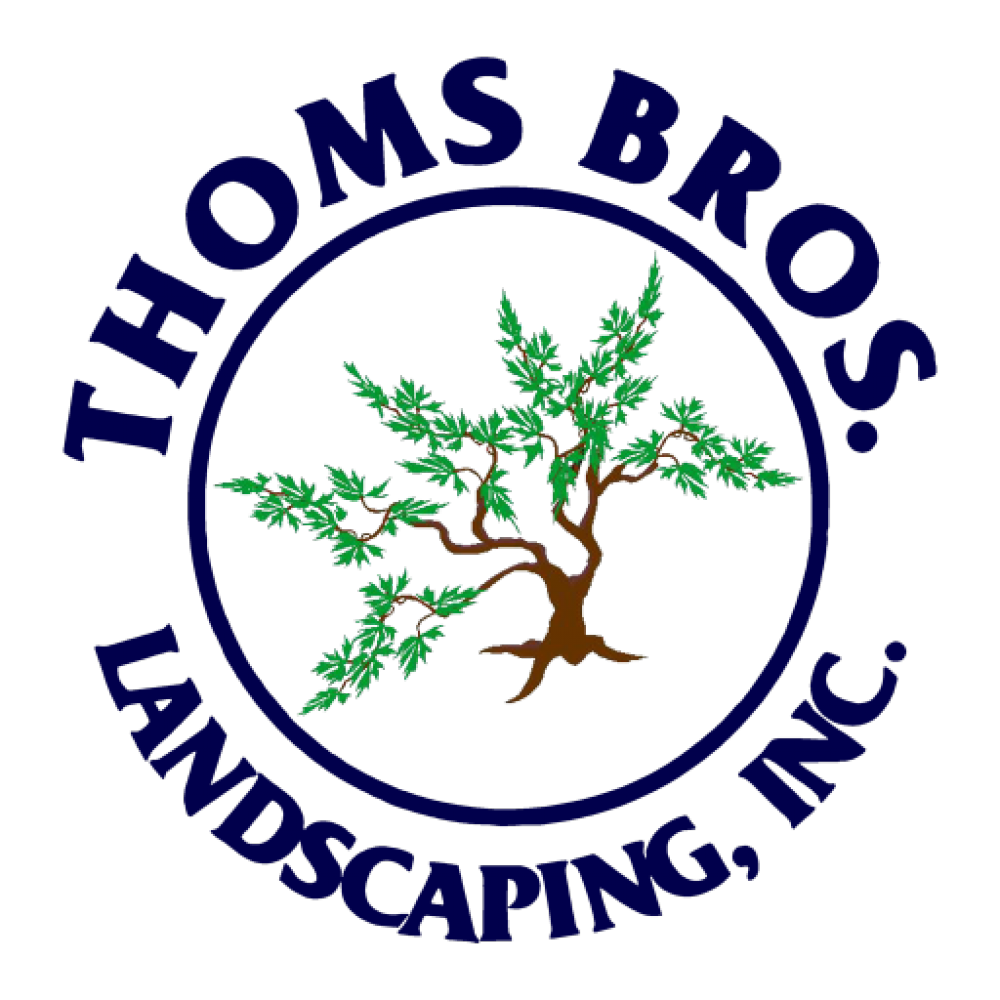As read in the July issue of the Landculptor.
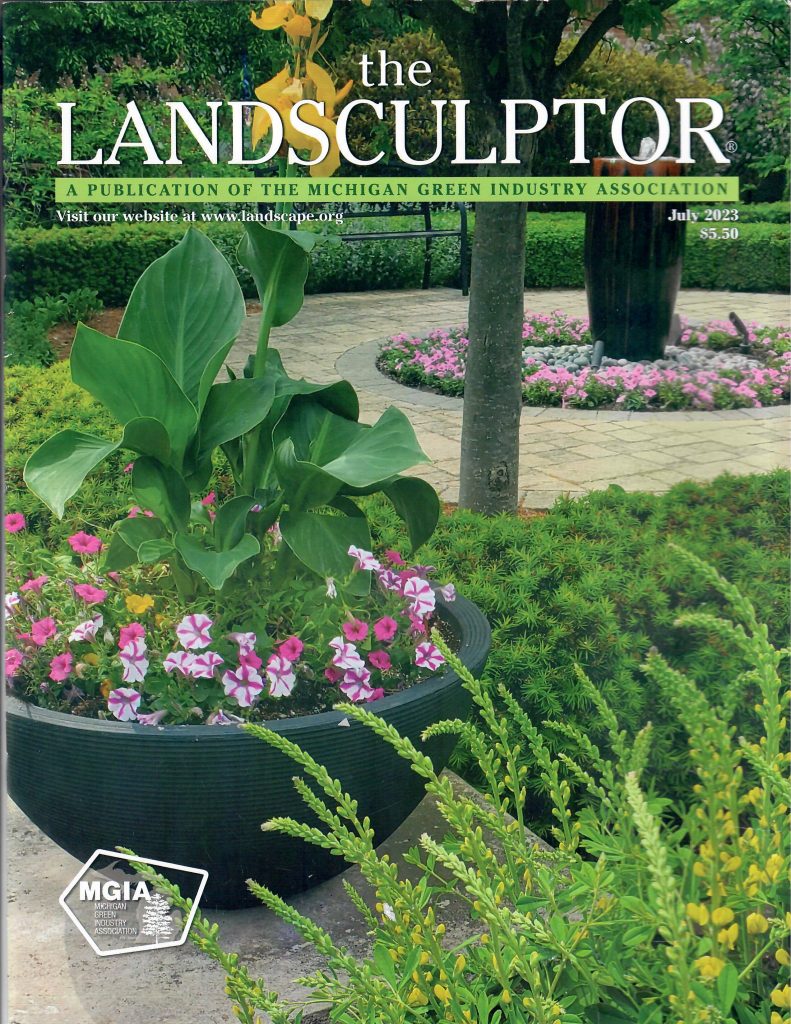
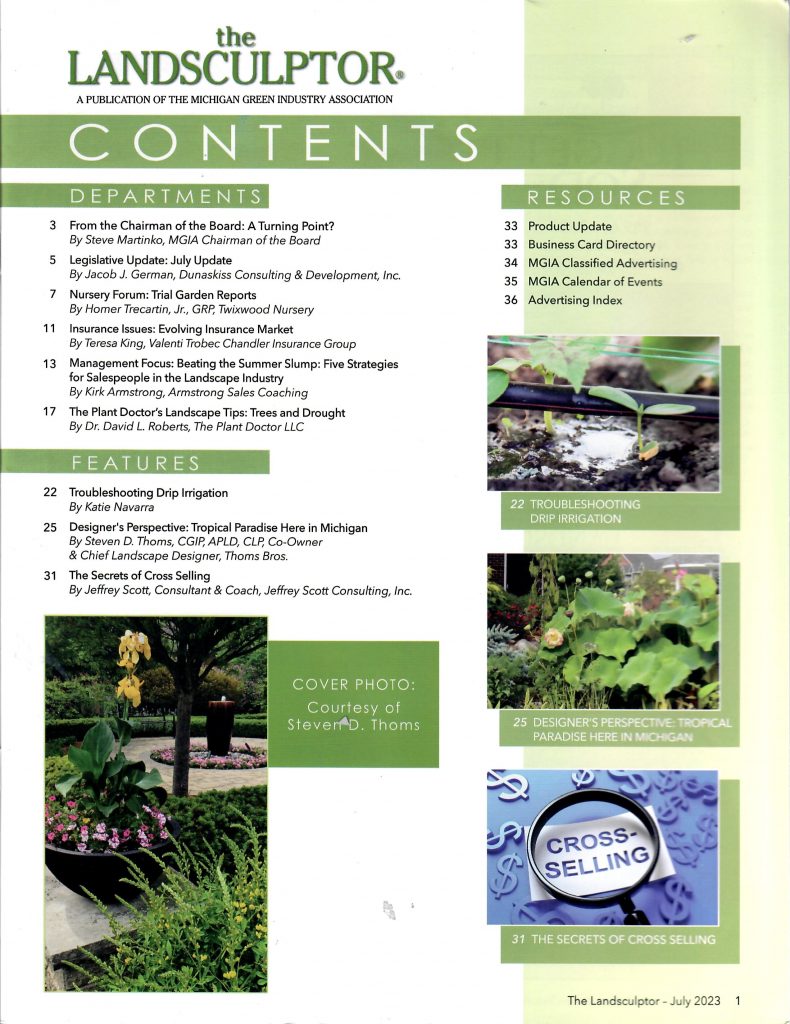
Why do people like to vacation in Florida and other tropical locations such as the Caribbean? Of course, it’s the warm weather but is there more? Is it the combination of warm weather and ocean views? Yes, but I believe there is more that attract people to these locations. I believe it is the exotic look and feeling that the lush, tropical plants give us.
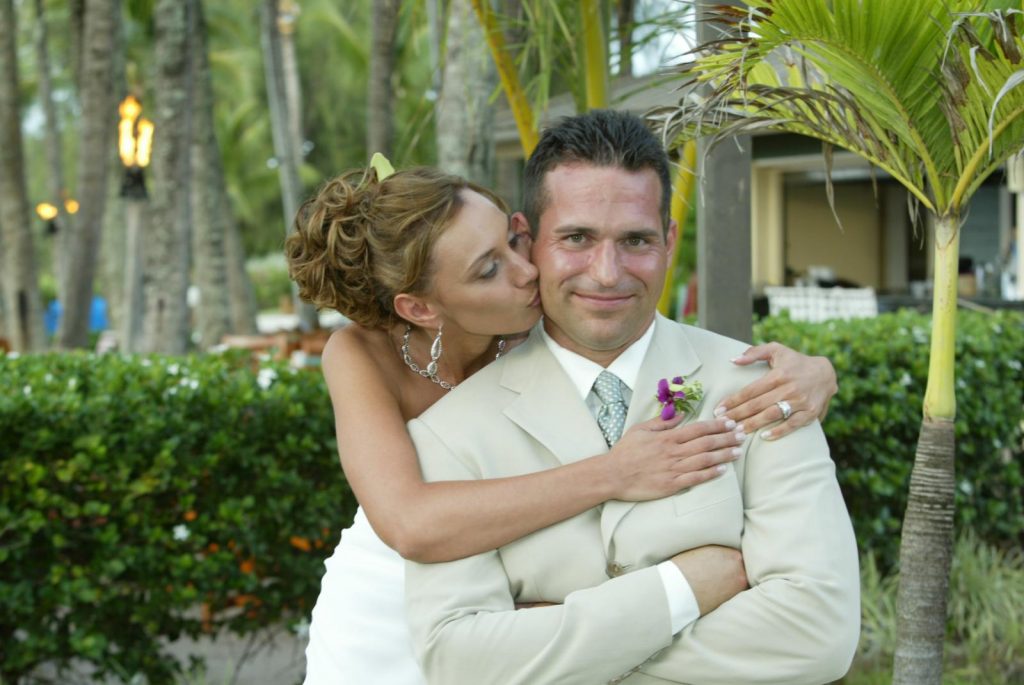
I appreciate all landscapes, even Michigan in the dead of winter. However, as a lover of plants, lush greenery stirs my heart. Whether it is walking through a woods in the heat of summer, upland bird hunting in a grass field with my German Shorthaired Pointer pup, or sitting on my patio on a beautiful Michigan summer night prolific plantings is my passion. I’ve been blessed to travel to many tropical locations in my lifetime including Hawaii, Bora Bora and the Caribbean. I was honored my beautiful wife took my hand in marriage on the island of Maui and then honeymoon on the Garden Isle of Kauaʻi. Leaving this cold, non-green state (plant wise) in the winter for a location with abundant greenery definitely needs to be more of a habit instead of an exception in my life.
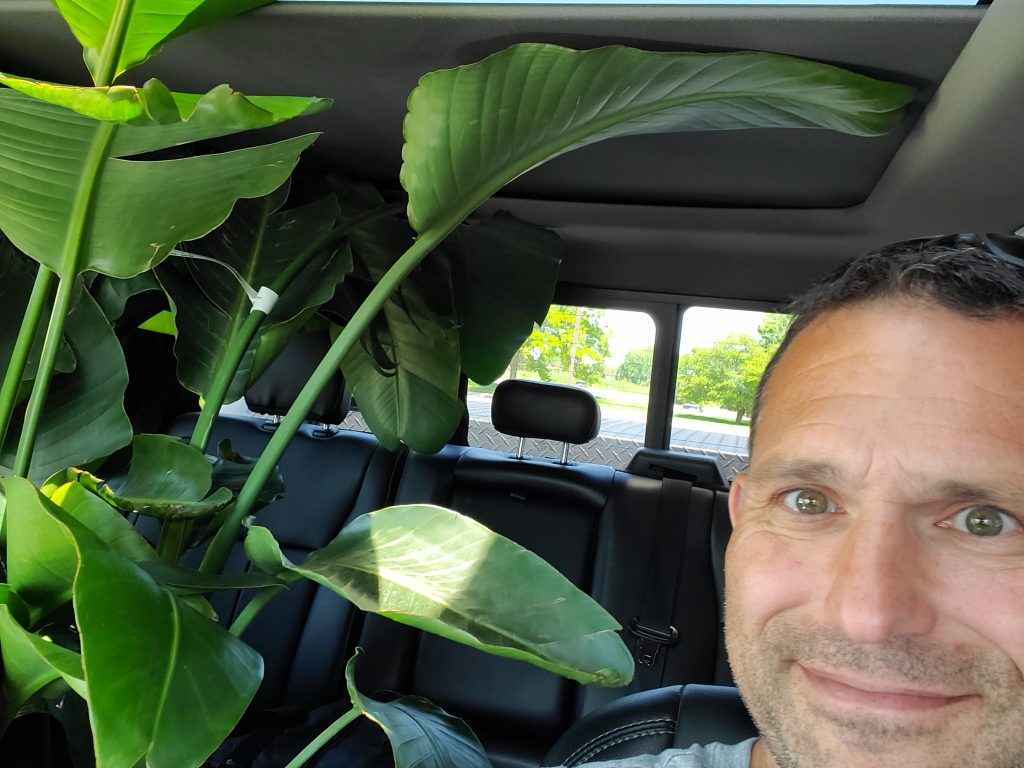
I believe you can definitely get a “tropical” feel without even having any tropical plants. The key to this look is to have a full landscape. Unfortunately, so many of the landscapes out there are individual plants with seas of mulch surrounding them usually at the bequest of the client. Clients see full landscapes improperly designed or not designed at all as “messy”. They believe individually placed plants with yards and yards of mulch is a more maintenance free landscape. I would beg to differ on this belief. Properly designed landscape with limited amount of ground space and flourishing plants gives weeds little area to prosper. A “full” look with some hardy tropical looking plants can be just enough to give you the “tropical” landscape.
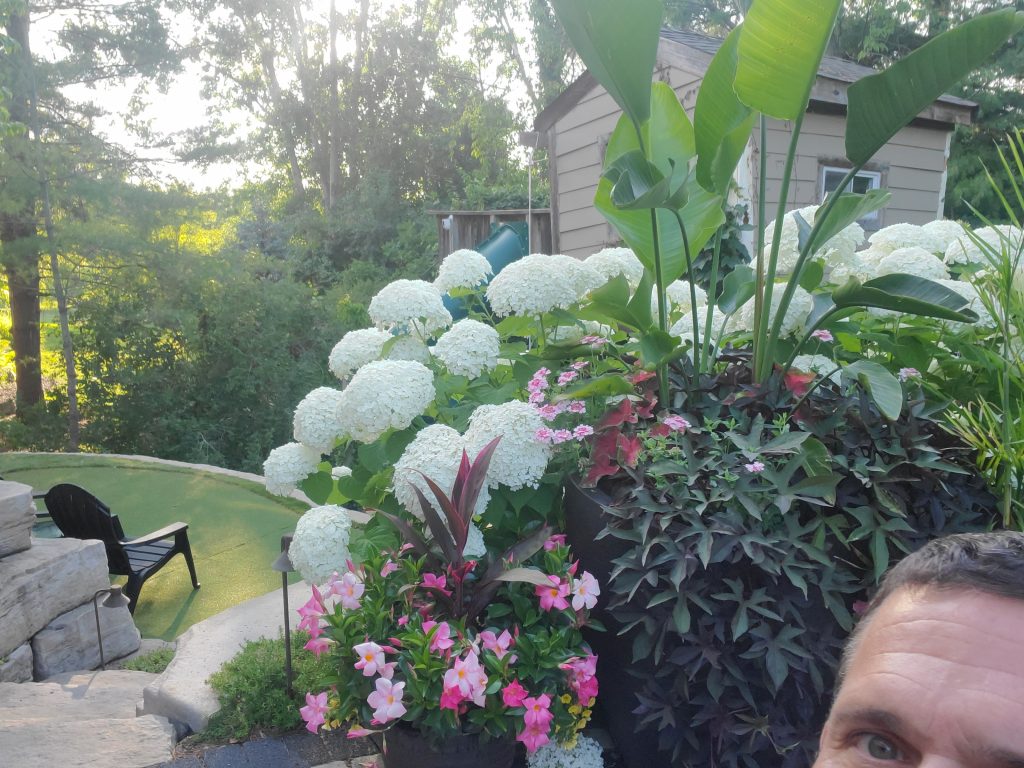
Maureen Gilmer states in her book, Water Works
“The key to creating a tropical paradise is based on two components: foliage and flowers. Tropical leaves tend to be very large, like those of houseplants, which are actually from tropical environments and cannot grow in the cold outside. The bigger and more interesting the leaves, the more tropical environment will appear. You can also push the frost line by exploring new ways to look at otherwise common temperate-zone plants.
The second defining element of this environment is flowers, which tend to be large and very bold-colored. Flowers can be produced on perennials, as well as shrubs, vines, and some small trees. Hot colors provide a warm-climate feeling, so emphasize bold flowers in red, orange, magenta, and yellow with purple and strong blues for accents.
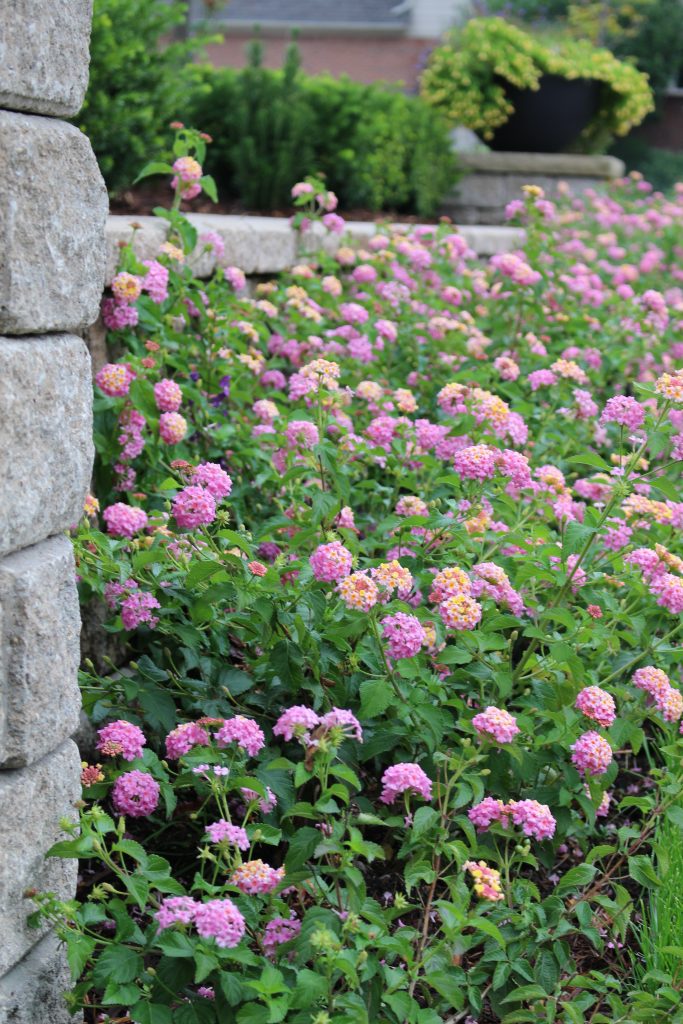
Compositions of plants for a tropical character should be densely planted in order to give that lush, junglelike appearance. Keep the taller plants with big leaves behind the smaller perennials to ensure all are equally visible. Also, plant the perennials in front of woody shrubs in order to cover up any exposed lower branches of stems.”
Another key for that “tropical” feel has to be water. If you’re lucky to live on a lake or river, then you might be all set for this feature. Water features can be as simple as a bubbling rock to a more advance koi pond with water fall(s) and/or a stream. Most water plants (i.e. Horsetail Rush, Iris, Pickerel Rush, Hardy and Tropical Water Lilies) naturally have a tropical feel to them. Of course, a swimming pool with some potted palm trees give you a tropical resort feeling.
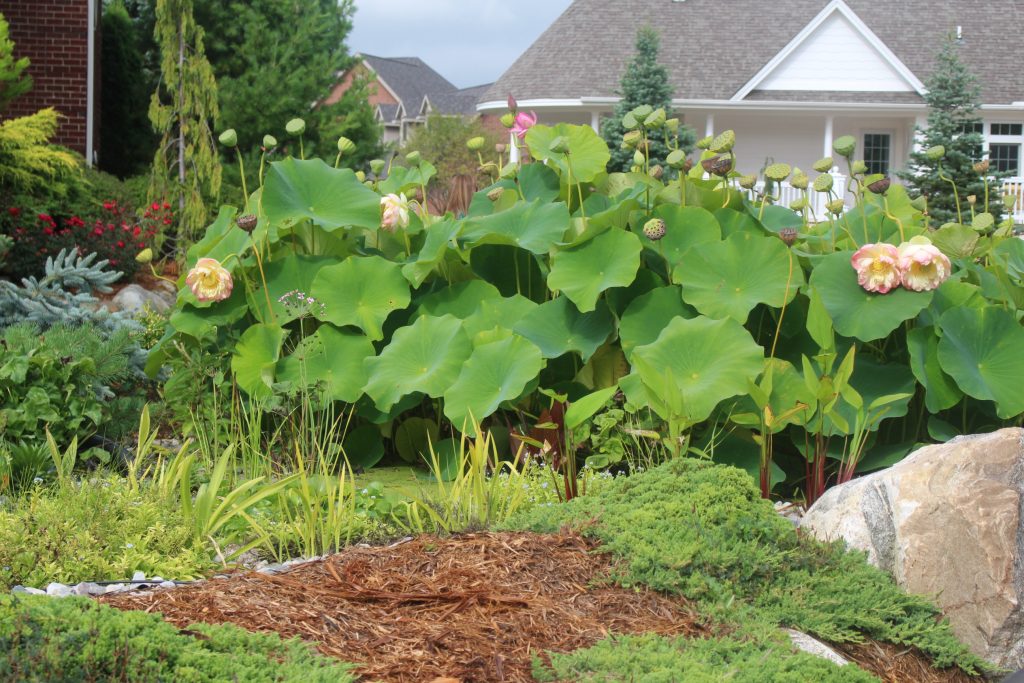
Adding a few exotics, truly tropical plants is always a topper on the cake. I was first introduced to this when my career in the landscape industry started back in 1991. My brother and I started taking over maintenance of his clients for an industry icon who was in the retirement stage. For many of his high-end clients, he would bring in Lantana trees and plant within the landscape. Then every Fall pull them out and overwinter in his greenhouse. Personally, I do not like orange flowers in the landscape except for Fall, but Lantana trees definitely have that exotic look.
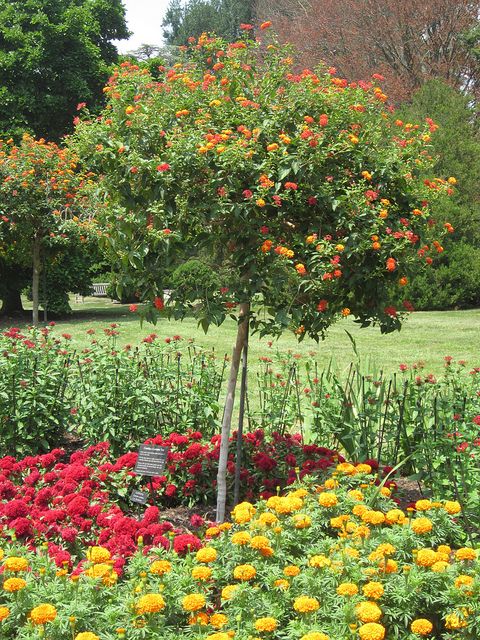
Below is a partial list of plants that can be used in Michigan for your tropical garden effect. Some plants can be interchanged in the categories listed below, such as: if you have a beautiful, large Colocasia (so you overwinter the tuber); you can get smaller Cat Palms at a very affordable price from a big box store so you treat it as an annual (throw it out at end of season); or, you can have a great microclimate area and you don’t mind spending some extra time winterizing a Hardy Banana to keep it in the ground treating it as a perennial. Some valuable time researching the internet as well as experience will help you determine what is best for your clients (and/or your personally).
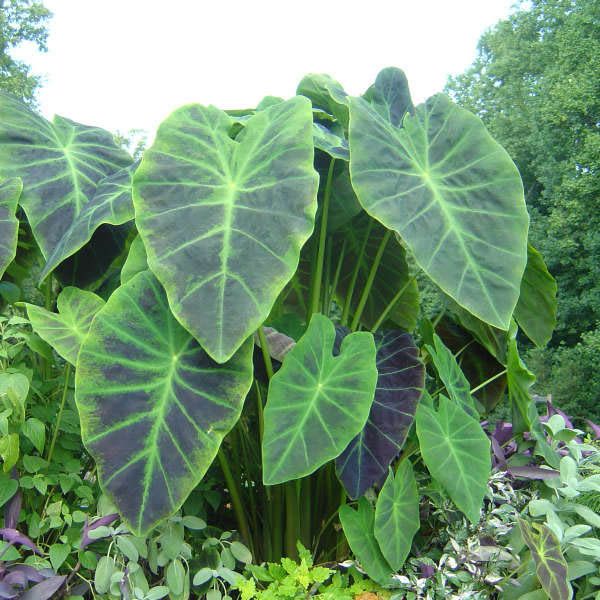
Topicals As Annuals
(herbaceous plants for zones 7-11 discarded at end of growing season)
- Cannas (Canna indica) are low-maintenance tropical plants, and they’re all about color. Their leaves sport various shades of green and bronze, and flowers bloom in yellow, red, orange, and fuchsia. Standard cannas grow 4 to 10 feet tall. Try dwarf varieties, which reach a mature height of just 1 to 2 feet and are excellent choices for containers. These tender perennials need to be dug in the fall and replanted in the spring.
- Elephant Ears (Colocasia esculenta)
- Heart of the Jungle Elephant’s Ear – By Proven Winners. The huge deep green leaves are a showstopper in any garden. 3-5’ tall. Grows in part sun to full sun.
- Coffee Cups Elephant’s Ear – By Proven Winners. At a glance, this might not seem like a very intriguing plant but the cupped leaves will gather rain drops until the weight of the water bends the plant stem and water pours out of the cupped leaf. It is an incredibly cool plant. I never grow tired of watching that process. The deep, olive-green foliage is handsome as well. 3-5’ tall. Grows in part sun to full sun.
- Bikini Tini – This unique Elephant Ear’s large, deep green leaves form cup-shapes, filling up with water in the rain! Plant Bikini-Tini in a container or in the ground for a gorgeous backdrop to your favorite flowers.
- Mandevilla The tropics are rampant with vines; your garden should be, too. Add mandevilla to the planting area, allowing it to ramble up a trellis or tree. Its 3- to 4-inch white or pink blooms lighten up dark foliage. Vines bridge the gaps between tall and short tropical growers by trailing color from the ground up.
- Caladium spp. is your tropical color that grows in more shaded areas. Available in many different colors, caladium loves moist soil, and is a bulb that can be dug up and stored inside until the following spring.
- Luscious Lantana (Lantana camara) is an impressive vigorous, landscape-sized annual in Michigan from Proven Winners. Use it as a groundcover, in a container all its own, or in large containers with other very vigorous plants. If you are looking for a plant that will thrive on neglect, lantana is the champ. Lantana come in many shapes, sizes and habits. Check size and habit information for the specific variety you are choosing to make sure it fits your needs.
- Tropical Hibiscus (Hibiscus rosa-sinensis) blooms are 5 to 12 inches across and available in a mix of warm colors. Crepe-paper-like flowers unfurl in mid to late summer during high tempatures.
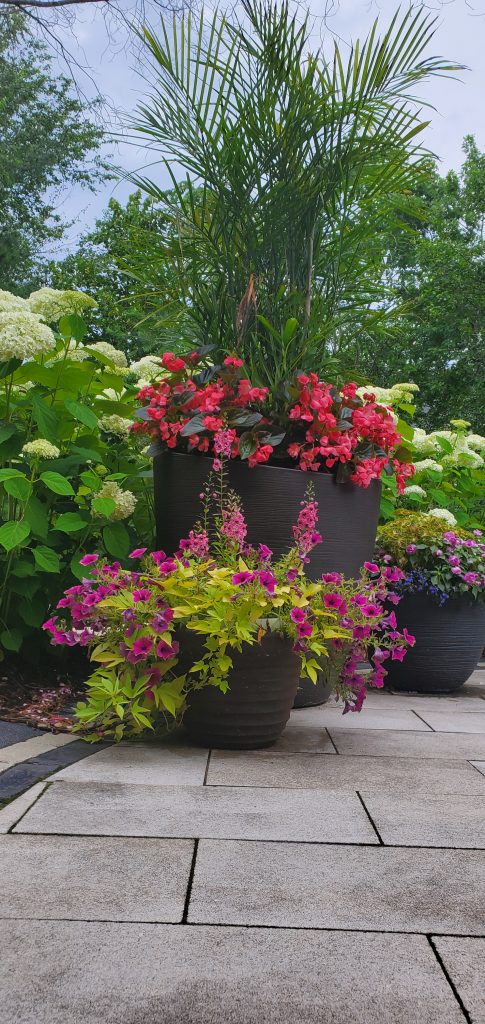
Topicals To Overwinter
(woody ornamental or perennial hardy to zones 7-11 overwintered in a house or greenhouse)
- Palms
- Jelly Palm (Butia capitata) is probably one of the hardiest cold tropical palms and is happy down to 10ºF. In cool climates, jelly palms stay reasonably compact, growing up to 10 to 20 feet tall. You can even grow jelly palms in containers, which keeps them even more compact.
- Cat Palm (Chamaedorea cataractarum) is a clustering palm with no trunk whatsoever, just a dense clump of stems covered with feathery fronds. This palm only grows 6 to 8 feet tall in a rounded form. These palms need regular watering, though they don’t like “wet feet.” These plants are perfect for bringing into the house for overwintering as long as you have a south facing window for it to sit in and you keep it humid (mist it or keep it on a water filled tray with pebbles)
- Sago Palm (Cycas revoluta) isn’t technically a true palm tree. These fairly low-growing plants with long green fronds are cycads, a group of ancient tropical and subtropical plants that usually grow from a trunk that doesn’t branch out; it produces nuts but doesn’t flower or fruit. Sago palms are native to warm parts of Japan and southern China.
- Chinese Fan Palm (Livistona chinensis) are also known by the common name fountain palm due to the way their fronds arch up and then spill downward like water from a fountain. Each frond can grow 40 to 60 inches long.
- Needle Palm (Rhapidophyllum hystrix) is a perennial shrub native to the southeastern U.S. Although it is native to this warmer region, the needle palm plant is actually very cold hardy and gardeners further north prize it for giving their beds and yards a more tropical look. It puts out multiple stems, with sharp needles that give the plant its name, and slowly grows into a large clump that may be approximately 6 feet across and high.
- Dwarf Palmetto Palm (Sabal minor) In a protected location, dwarf palmetto is considered to be winter hardy to USDA Zone 7. It is not reliably winter hardy in the St. Louis area where it may not survive harsh winters. It is typically grown in organically rich, moderately fertile, evenly moist but well-drained soils in full sun to part shade. Best performance is in part shade. Site in protected locations that are sheltered from winter winds. Established plants will often survive some 0-degree F. temperatures in winter.
- Windmill Palm (Trachycarpus fortunei) is an attractive, cold-hardy palm tree that can be grown in zone 7 in a sheltered location. It is known for its fan-shaped leaves that grow in a circular pattern at the end of long stems and can span up to 3 feet across.
- Hardy Banana
- (Musa basjoo) is considered winter hardy to zone 5 if well-mulched. Although it produces cream to yellow flowers in the summer, followed by inedible fruit, it is mostly grown for its large, tropical looking leaves. In colder zones, it is a perennial that will die down to the ground in the winter. It should be planted in a location that is protected from the wind, since the large leaves are susceptible to wind damage.
- (Ensete ventrico0sum ‘Maurelli’) is another stunning banana with huge, broad leaves in wine-red and bronze tones. Unlike Musa basjoo, it must be overwintered indoors in Michigan.
- Bird of Paradise (Strelitzia reginae) is a fabulous and flashy plant which brings sizzling tropical color flowers to a vase or your landscape. The blossoms resemble a bird in flight or an artfully folded origami sculpture. The spiky explosion of petals from the flower bud also mimics the head of a crowned crane, giving rise to another common name, crane flower. Whatever you call it, this bloomer is beautiful.
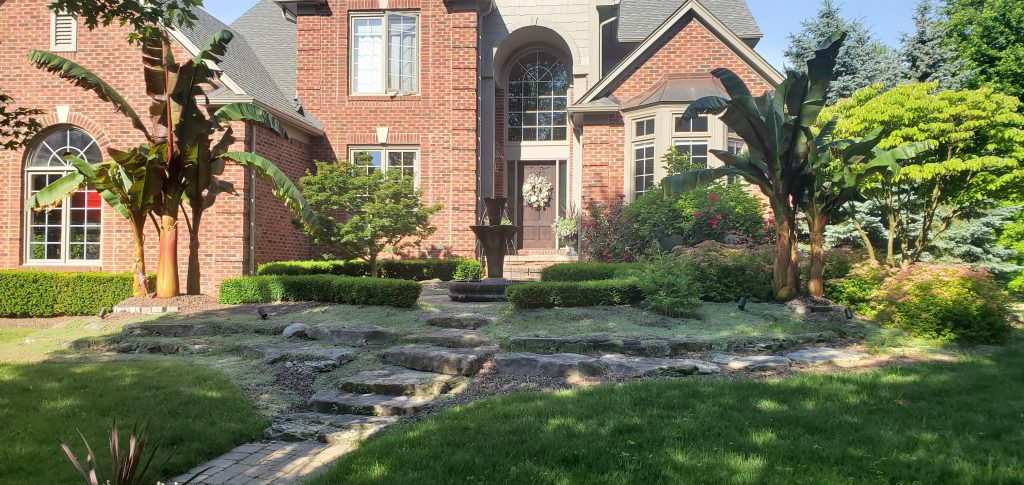
Tropical Looking Plants
(woody ornamental or perennial hardy to zones 5-6)
- Hungarian Bear’s Breeches (Acanthus hungaricus) is a clump former with dark green, deeply lobed basal leaves up to 2 feet or more in length. These alone make for an interesting plant with superior architectural qualities. However, Hungarian bear’s breeches is also a unique bloomer with tall vertical spikes of white to pale pink, purple-bracted flowers early to mid-summer. It is excellent as an accent plant and can even be used enmasse as a ground cover.
- Spiny Bear’s Breeches (Acanthus spinosus) is an imposing species with lustrous deep green, sharply and prominently toothed, deeply divided, oval to oblong, absolutely magnificent foliage. This alone would make spiny bear’s breeches a worthy plant, but its flowers are even more amazing. Blooming late spring and early summer with massive upright spikes of pinkish petaled, purple bracted flowers, spiny bear’s breeches put on an outstanding floral show.
- Clumping Bamboos (Fargesia rufa) Nonrunning, clump-forming, vigorous, and cold hardy, F. rufa is an exciting evergreen specimen, accent plant when grouped, or effective hedge or screen. It is clothed in attractive shiny green foliage, has the habit of a fountain, and in maturity can form clumps reaching 8 feet across. It prefers organically rich soils, but does well in most slightly acidic well drained soils.
- Seven-Son Flower Temple of Bloom (Heptacodium miconioides) is a beautiful, easy to grow small tree which simply can’t be matched for year-round beauty. In spring, the handsome leaves emerge, each sporting dramatically deep veins that make the plant stand out in the landscape. As the season progresses, the leaves grow larger and develop a long, twisting tip. Come August, when everything else is winding down, Temple of Bloom seven-son flower is just coming into its own, as it becomes covered in big clusters of fragrant white flowers that hummingbirds and other pollinators flock to. This plant is a great Crape Myrtle alternative for Michigan.
- Hibiscus that grows in temperate climates aren’t the same as the iconic tropical hibiscus, but their massive, beautiful flowers look positively tropical. The perennial Hibiscus moscheutos (rose mallow) is hardy to Zone 4 and grows to an astounding 7 feet tall with a 4-foot spread. Various cultivars have been developed with plate-sized flowers in shades of white, pink and red.
- Hosta is among the most tropical-looking hardy plants with their wide range of leaf colors and sizes. Some are miniatures a few inches wide; others are giants that sprawl 6 feet across or more.
- Torch Lily (Kniphofia) the striking, red hot poker plant (Kniphofia uvaria) is in the Liliaceae family and is also known as poker plant and torch lily. This plant thrives in USDA zones 5 through 9 and is an upright evergreen perennial with a clumping habit. Over 70 known species exist of this South African native plant.
- Ligulara (Ligulara dentata & stenocephala) has several varieties that are hardy to Michigan and offer that tropical feel. Fine and robust foliage with large rich green leaves and rich texture. The dentata variety have a bronze new growth color with deep purple underside. Both offer a fabulous exotic looking flower.
- Lotus (Nelumbo Spp) is an aquatic plant with interesting leaves and stunning flowers. It’s most commonly grown in water gardens.
- Japanese Butterbur (Petasites japonicus) unique, fan-shaped leaves can grow up to three feet wide. Japanese butterbur can handle any type of soil and even thrives in full shade and loves moisture.
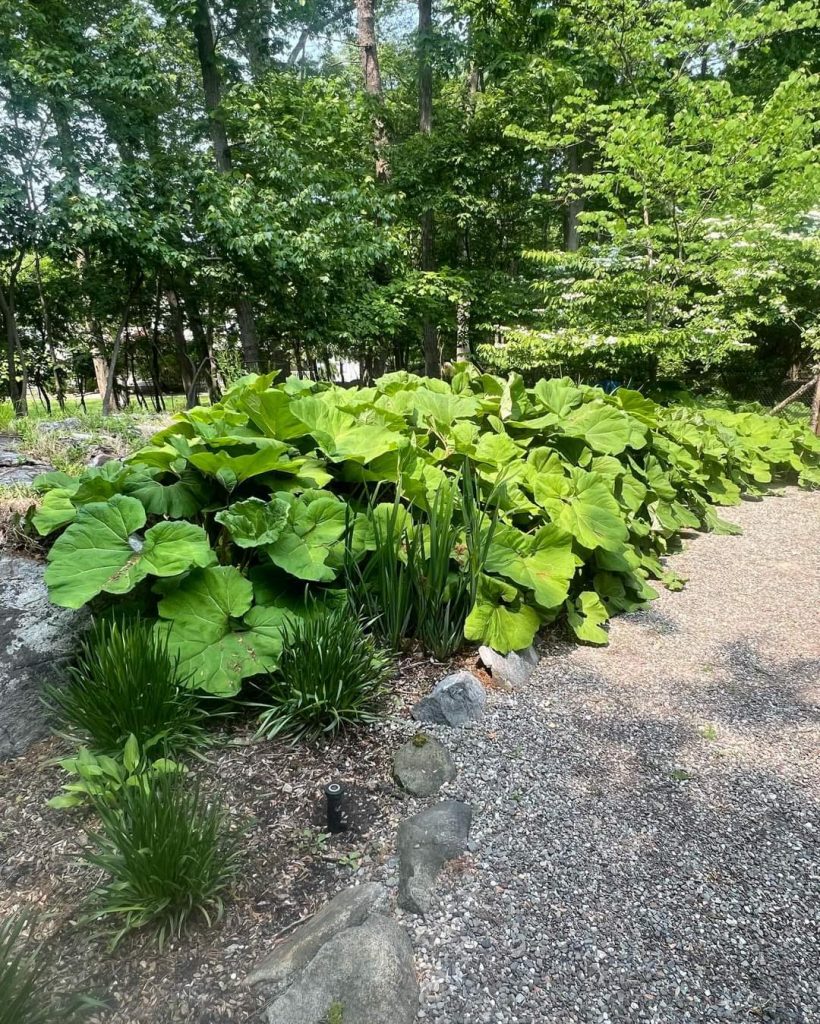
- Ferns (Tracheophyta) can be a great addition to your garden to give it a tropical look. Some of the most cold-hardy ferns that you can grow are Western maidenhair fern, Lady fern, Christmas fern, Western sword fern, and Common polypody.
- Yucca Adam’s Needle (Yucca filamentosa) is a slow-growing broadleaf evergreen succulent often used in Southwest-themed landscapes. A yucca plant in the asparagus family, Adam’s needle is a virtually stemless shrub with blade-like leaves that form a basal rosette. The foliage clumps are usually 2 to 3 feet tall, with curled threads lining the edges of the leaves
Any of the above plants can create a piece of paradise in Michigan.
Steven D. Thoms, CGIP, FAPLD, LIC-M is an internationally certified landscape designer through the Association of Professional Landscape Designers (APLD). He is Vice President and Chief Designer at Thoms Bros. Landscaping, Inc. in Macomb, MI. Thoms Bros. Landscaping, Inc. is an award-winning landscape design, build and management firm serving Southeast Michigan since 1991.
